2010 湖南考研英语二真题及答案
Section I Use of English
Directions: Read the following passage. For each numbered blank there are four
choices marked A, B, C and D. Choose the best one and mark your answers on
ANSWER SHEET l. (10 points)
The outbreak of swine flu that was first detected in Mexico was declared a global
epidemic on June 11, 2009. It is the first worldwide epidemic__1__ by the World
Health Organization in 41 years.
The heightened alert ___2__an emergency meeting with flu experts in Geneva
that convened after a sharp rise in cases in Australia, and rising___3___in Britain,
Japan, Chile and elsewhere.
But the epidemic is "__4__" in severity, according to Margaret Chan, the
organization's director general, __5__ the overwhelming majority of patients
experiencing only mild symptoms and a full recovery, often in the __6___ of any
medical treatment.
The outbreak came to global__7__in late April 2009, when Mexican authorities
noticed an unusually large number of hospitalizations and deaths__8___healthy
adults. As much of Mexico City shut down at the height of a panic, cases began to
__9___in New York City, the southwestern United States and around the world.
In the United States, new cases seemed to fade__10__warmer weather arrived.
But in late September 2009, officials reported there was __11__flu activity in almost
every state and that virtually all the__12___tested are the new swine flu, also known
as (A) H1N1, not seasonal flu. In the U.S., it has__13__more than one million people,
and caused more than 600 deaths and more than 6,000 hospitalizations.
Federal health officials__14___Tamiflu for children from the national stockpile
and began__15__orders from the states for the new swine flu vaccine. The new
vaccine, which is different from the annual flu vaccine, is __16__ ahead of
expectations. More than three million doses were to be made available in early
October 2009, though most of those __17__doses were of the FluMist nasal spray
type, which is not__18__for pregnant women, people over 50 or those with breathing
difficulties, heart disease or several other __19__. But it was still possible to
vaccinate
people in other high-risk group: health care workers, people __20___infants and
healthy young people.
1 [A] criticized
[B] appointed
[C]commented
[D] designated
2 [A] proceeded
[B] activated
[C] followed
�
[D] prompted
3 [A] digits
[B] numbers
[C] amounts
[D] sums
4 [A] moderate
[B] normal
[C] unusual
[D] extreme
5 [A] with [B] in [C] from
[D] by
6 [A] progress
[B] absence
[C] presence
[D] favor
7 [A] reality
[B] phenomenon
[C] concept
[D] notice
8 [A]over
[B] for
[C] among
[D] to
9 [A] stay up
[B] crop up
[C] fill up
[D] cover up
10 [A] as
[B] if
[C] unless
[D] until
11 [A] excessive
[B] enormous
[C] significant
[D]magnificent
12 [A]categories
[B] examples
[C] patterns
[D]
samples
13 [A] imparted
[B] immerse
[C] injected
[D] infected
�
14 [A] released
[B] relayed
[C] relieved
[D] remained
15 [A] placing [B] delivering
[C] taking
[D] giving
16 [A] feasible
[B] available
[C] reliable
[D] applicable
17 [A] prevalent
[B] principal
[C] innovative
[D] initial
18 [A] presented
[B] restricted
[C] recommended
[D]
introduced
19 [A] problems
[B] issues
[C] agonies
[D] sufferings
20 [A] involved in
[B] caring for
[C] concerned with
[D]
warding off
Section Ⅱ Reading comprehension
Part A
Directions:
Read the following four passages. Answer the questions below each passage
by choosing A, B, C and D. Mark your answers on ANSWER SHEET 1. (40
points)
Text1
The longest bull run in a century of art-market history ended on a dramatic note
with a sale of 56 works by Damien Hirst, “Beautiful Inside My Head Forever”,
at
Sotheby’s in London on September 15th 2008. All but two pieces sold, fetching more
than £70m, a record for a sale by a single artist. It was a last victory. As the
auctioneer called out bids, in New York one of the oldest banks on Wall Street,
Lehman Brothers, filed for bankruptcy.
The world art market had already been losing momentum for a while after rising
�
bewilderingly since 2003. At its peak in 2007 it was worth some $65 billion, reckons
Clare Mc Andrew, founder of Arts Economics, a research firm—double the figure
five years earlier. Since then it may have come down to $50 billion. But the market
generates interest far beyond its size because it brings together great wealth,
enormous egos, greed, passion and controversy in a way matched by few other
industries.
In the weeks and months that followed Mr. Hirst’s sale, spending of any sort
became deeply unfashionable, especially in New York, where the bail-out of the
banks coincided with the loss of thousands of jobs and the financial demise of many
art-buying investors. In the art world that meant collectors stayed away from
galleries
and salerooms. Sales of contemporary art fell by two-thirds, and in the most
overheated sector—for Chinese contemporary art—they were down by nearly 90% in
the year to November 2008. Within weeks the world’s two biggest auction houses,
Sotheby’s and Christie’s, had to pay out nearly $200m in guarantees to clients
who
had placed works for sale with them.
The current downturn in the art market is the worst since the Japanese stopped
buying Impressionists at the end of 1989, a move that started the most serious
contraction in the market since the Second World War. This time experts reckon that
prices are about 40% down on their peak on average, though some have been far more
fluctuant. But Edward Dolman, Christie’s chief executive, says: “I’m pretty
confident
we’re at the bottom.”
What makes this slump different from the last, he says, is that there are still
buyers in the market, whereas in the early 1990s, when interest rates were high,
there
was no demand even though many collectors wanted to sell. Christie’s revenues in
the
first half of 2009 were still higher than in the first half of 2006. Almost everyone
who
was interviewed for this special report said that the biggest problem at the moment
is
not a lack of demand but a lack of good work to sell. The three Ds—death, debt and
divorce—still deliver works of art to the market. But anyone who does not have to
sell
is keeping away, waiting for confidence to return.
21. In the first paragraph, Damien Hirst's sale was referred to as “a last victory”
because ____.
A. the art market had witnessed a succession of victories
B. the auctioneer finally got the two pieces at the highest bids
C. Beautiful Inside My Head Forever won over all masterpieces
D. it was successfully made just before the world financial crisis
�
22.By saying “spending of any sort became deeply unfashionable”(Line 1-2,Para.3),
the author suggests that_____.
A. collectors were no longer actively involved in art-market auctions
B .people stopped every kind of spending and stayed away from galleries
C. art collection as a fashion had lost its appeal to a great extent
D .works of art in general had gone out of fashion so they were not worth buying
23. Which of the following statements is NOT true?
A .Sales of contemporary art fell dramatically from 2007 to 2008.
B. The art market surpassed many other industries in momentum.
C. The market generally went downward in various ways.
D. Some art dealers were awaiting better chances to come.
24. The three Ds mentioned in the last paragraph are ____
A. auction houses ' favorites B. contemporary trends
C. factors promoting artwork circulation D. styles representing impressionists
25. The most appropriate title for this text could be ___
A. Fluctuation of Art Prices
B. Up-to-date Art Auctions
C. Art Market in Decline
D. Shifted Interest in Arts
TEXT2
I was addressing a small gathering in a suburban Virginia living room—a
women's group that had invited men to join them. Throughout the evening one man
had been particularly talkative, frequently offering ideas and anecdotes, while his
wife
sat silently beside him on the couch. Toward the end of the evening I commented that
women frequently complain that their husbands don't talk to them. This man quickly
nodded in agreement. He gestured toward his wife and said, "She's the talker in our
family." The room burst into laughter; the man looked puzzled and hurt. "It's true,"
he
explained. "When I come home from work, I have nothing to say. If she didn't keep
the conversation going, we'd spend the whole evening in silence."
This episode crystallizes the irony that although American men tend to talk more
than women in public situations, they often talk less at home. And this pattern is
wreaking havoc with marriage.
The pattern was observed by political scientist Andrew Hacker in the late 1970s.
Sociologist Catherine Kohler Riessman reports in her new book "DivorceTalk" that
most of the women she interviewed—but only a few of the men—gave lack of
communication as the reason for their divorces. Given the current divorce rate of
nearly 50 percent,that amounts to millions of cases in the United States every year
—a virtual epidemic of failed conversation.
In my own research complaints from women about their husbands most often
focused not on tangible inequities such as having given up the chance for a career
to
accompany a husband to his or doing far more than their share of daily life-support
�
work like cleaning, cooking, social arrangements and errands. Instead they focused
on
communication: "He doesn't listen to me." "He doesn't talk to me." I found as Hacker
observed years before that most wives want their husbands to be first and foremost
conversational partners but few husbands share this expectation of their wives.
In short the image that best represents the current crisis is the stereotypical
cartoon scene of a man sitting at the breakfast table with a newspaper held up in
front
of his face, while a woman glares at the back of it, wanting to talk.
26. What is most wives' main expectation of their husbands?
A. Talking to them. B. Trusting them. C. Supporting their careers. D.
Sharing housework.
27. Judging from the context, the phrase “wreaking havoc”(Line 3,Para.2)most
probably means ___ .
A. generating motivation. B. exerting influence C. causing damage D.
creating pressure
28. All of the following are true EXCEPT_______
A. men tend to talk more in public than women
B. nearly 50 percent of recent divorces are caused by failed conversation
C. women attach much importance to communication between couples
D. a female tends to be more talkative at home than her spouse
29. Which of the following can best summarize the main idea of this text?
A. The moral decaying deserves more research by sociologists.
B. Marriage break-up stems from sex inequalities.
C. Husband and wife have different expectations from their marriage.
D. Conversational patterns between man and wife are different.
30. In the following part immediately after this text, the author will most probably
focus on ______
A. a vivid account of the new book Divorce Talk
B. a detailed description of the stereotypical cartoon
C. other possible reasons for a high divorce rate in the U.S.
D. a brief introduction to the political scientist Andrew Hacker
Text 3
Over the past decade, many companies had perfected the art of creating
automatic behaviors — habits — among consumers. These habits have helped
companies earn billions of dollars when customers eat snacks, apply lotions and wipe
counters almost without thinking, often in response to a carefully designed set of
daily
cues.
“There are fundamental public health problems, like dirty hands instead of a soap
habit, that remain killers only because we can’t figure out how to change people’
s
habits,” Dr. Curtis said. “We wanted to learn from private industry how to create
new
�
behaviors that happen automatically.”
The companies that Dr. Curtis turned to — Procter & Gamble, Colgate
Palmolive and Unilever — had invested hundreds of millions of dollars finding the
subtle cues in consumers’ lives that corporations could use to introduce new
routines.
If you look hard enough, you’ll find that many of the products we use every day
— chewing gums, skin moisturizers, disinfecting wipes, air fresheners, water
purifiers, health snacks, antiperspirants, colognes, teeth whiteners, fabric
softeners,
vitamins— are results of manufactured habits. A century ago, few people regularly
brushed their teeth multiple times a day. Today, because of canny advertising and
public health campaigns, many Americans habitually give their pearly whites a
cavity-preventing scrub twice a day, often with Colgate, Crest or one of the other
brands.
A few decades ago, many people didn’t drink water outside of a meal. Then
beverage companies started bottling the production of far-off springs, and now
office
workers unthinkingly sip bottled water all day long. Chewing gum, once bought
primarily by adolescent boys, is now featured in commercials as a breath freshener
and teeth cleanser for use after a meal. Skin moisturizers are advertised as part
of
morning beauty rituals, slipped in between hair brushing and putting on makeup.
“Our products succeed when they become part of daily or weekly patterns,” said
Carol Berning, a consumer psychologist who recently retired from Procter & Gamble,
the company that sold $76 billion of Tide, Crest and other products last year.
“Creating positive habits is a huge part of improving our consumers’ lives, and
it’s
essential to making new products commercially viable.”
Through experiments and observation, social scientists like Dr. Berning have
learned that there is power in tying certain behaviors to habitual cues through
relentless advertising. As this new science of habit has emerged, controversies have
erupted when the tactics have been used to sell questionable beauty creams or
unhealthy foods.
31. According to Dr. Curtis, habits like hand washing with soap________.
A. should be further cultivated
B. should be changed gradually
C. are deeply rooted in history
D. are basically private concerns
32. Bottled water, chewing gun and skin moisturizers are mentioned in Paragraph 5
so
as to____
A. reveal their impact on people’s habits
B. show the urgent need of daily necessities
C. indicate their effect on people’s buying power
�
D. manifest the significant role of good habits
33. Which of the following does NOT belong to products that help create people’
s
habits?
A. Tide
B. Crest
C. Colgate
D. Unilever
34. From the text we know that some of consumer’s habits are developed due to
_____
A. perfected art of products
B. automatic behavior creation
C. commercial promotions
D. scientific experiments
35. The author’s attitude toward the influence of advertisement on people’s habits
is____
A. indifferent
B. negative
C. positive
D. biased
Text4
Many Americans regard the jury system as a concrete expression of crucial
democratic values, including the principles that all citizens who meet minimal
qualifications of age and literacy are equally competent to serve on juries; that
jurors
should be selected randomly from a representative cross section of the community;
that no citizen should be denied the right to serve on a jury on account of race,
religion, sex, or national origin; that defendants are entitled to trial by their
peers; and
that verdicts should represent the conscience of the community and not just the
letter
of the law. The jury is also said to be the best surviving example of direct rather
than
representative democracy. In a direct democracy, citizens take turns governing
themselves, rather than electing representatives to govern for them.
But as recently as in 1986, jury selection procedures conflicted with these
democratic ideals. In some states, for example, jury duty was limited to persons
of
supposedly superior intelligence, education, and moral character. Although the
Supreme Court of the United States had prohibited intentional racial discrimination
in
jury selection as early as the 1880 case of Strauder v. West Virginia, the practice
of
�
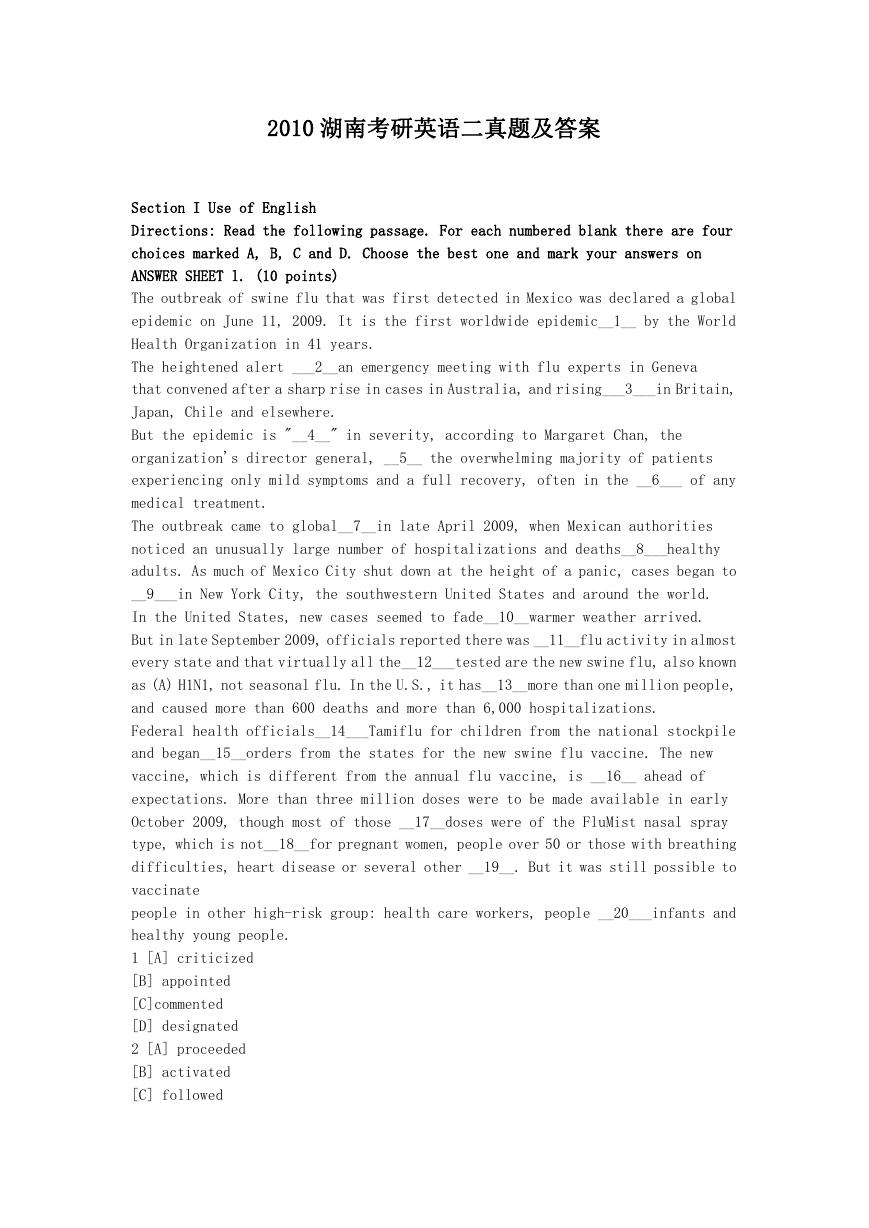
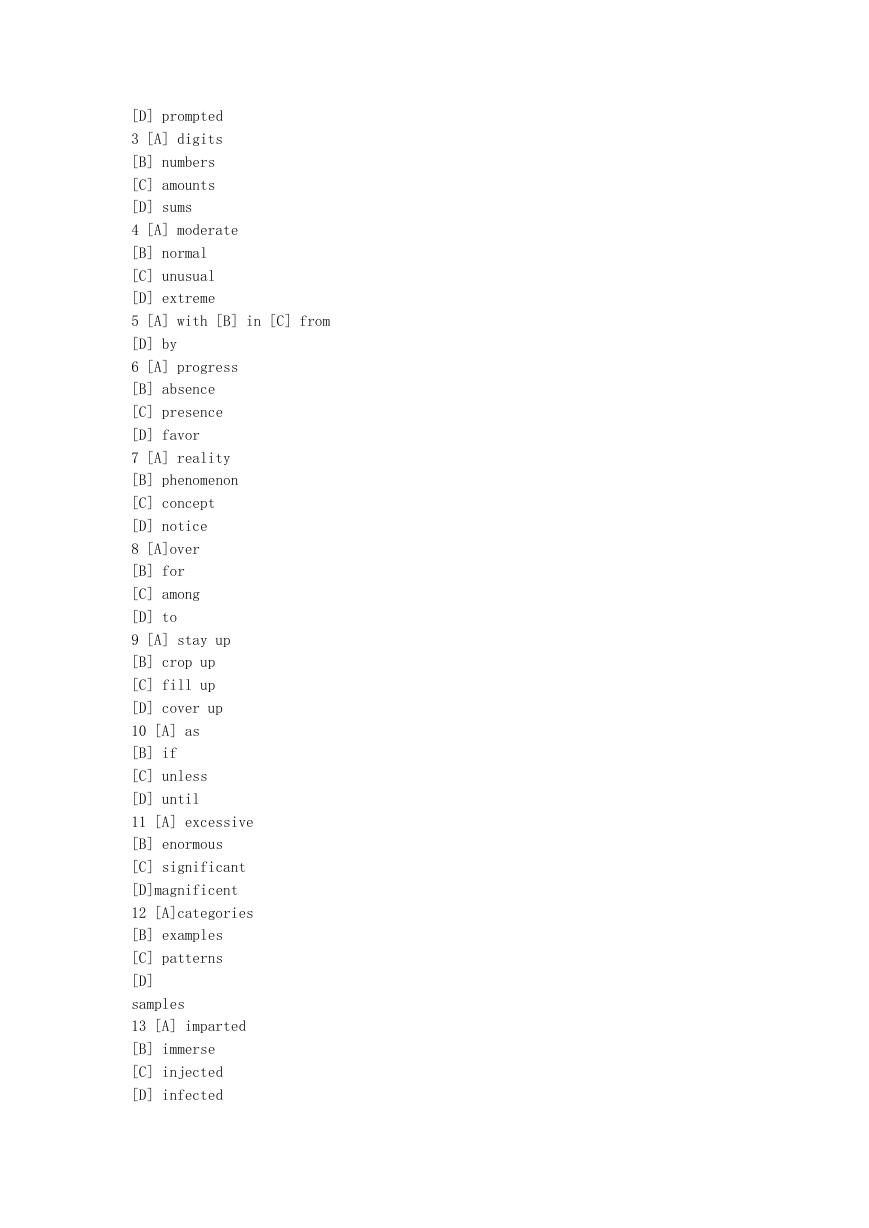

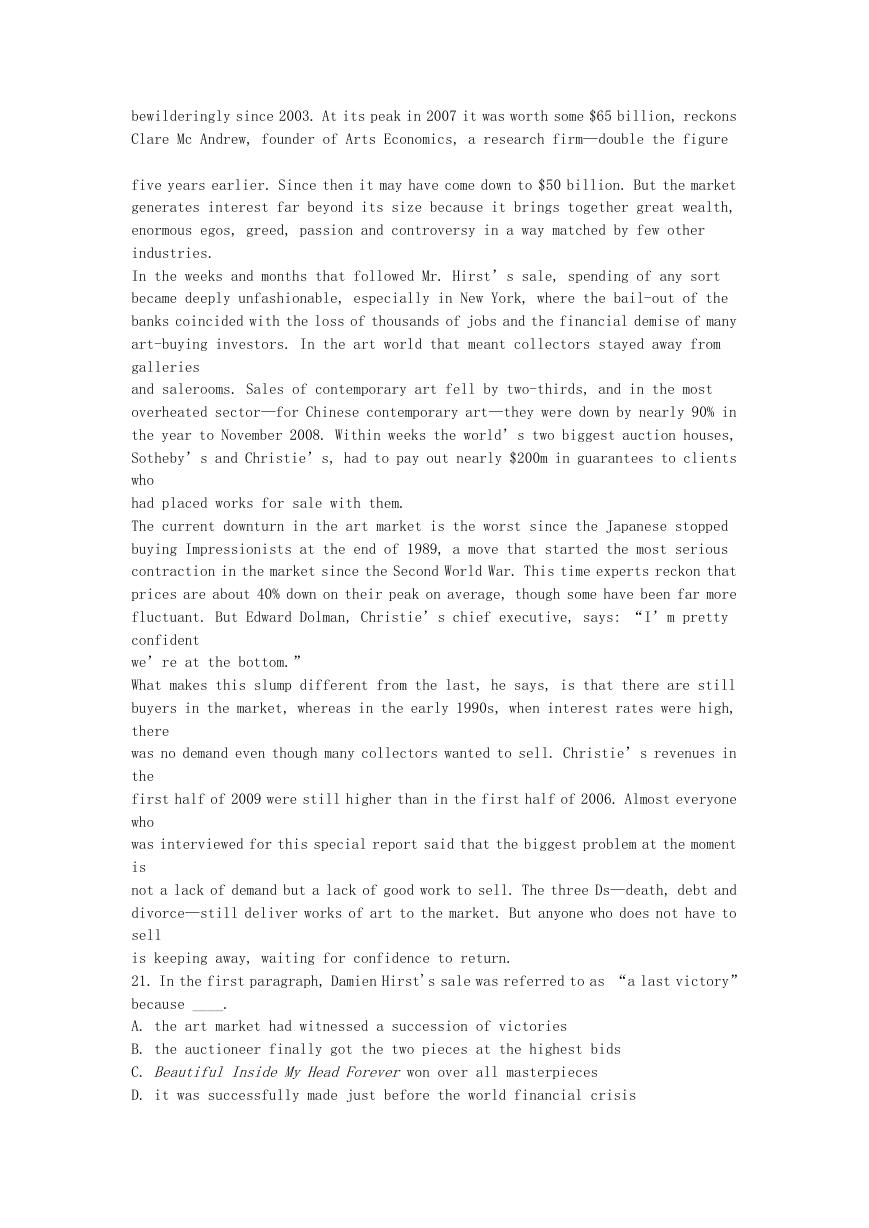

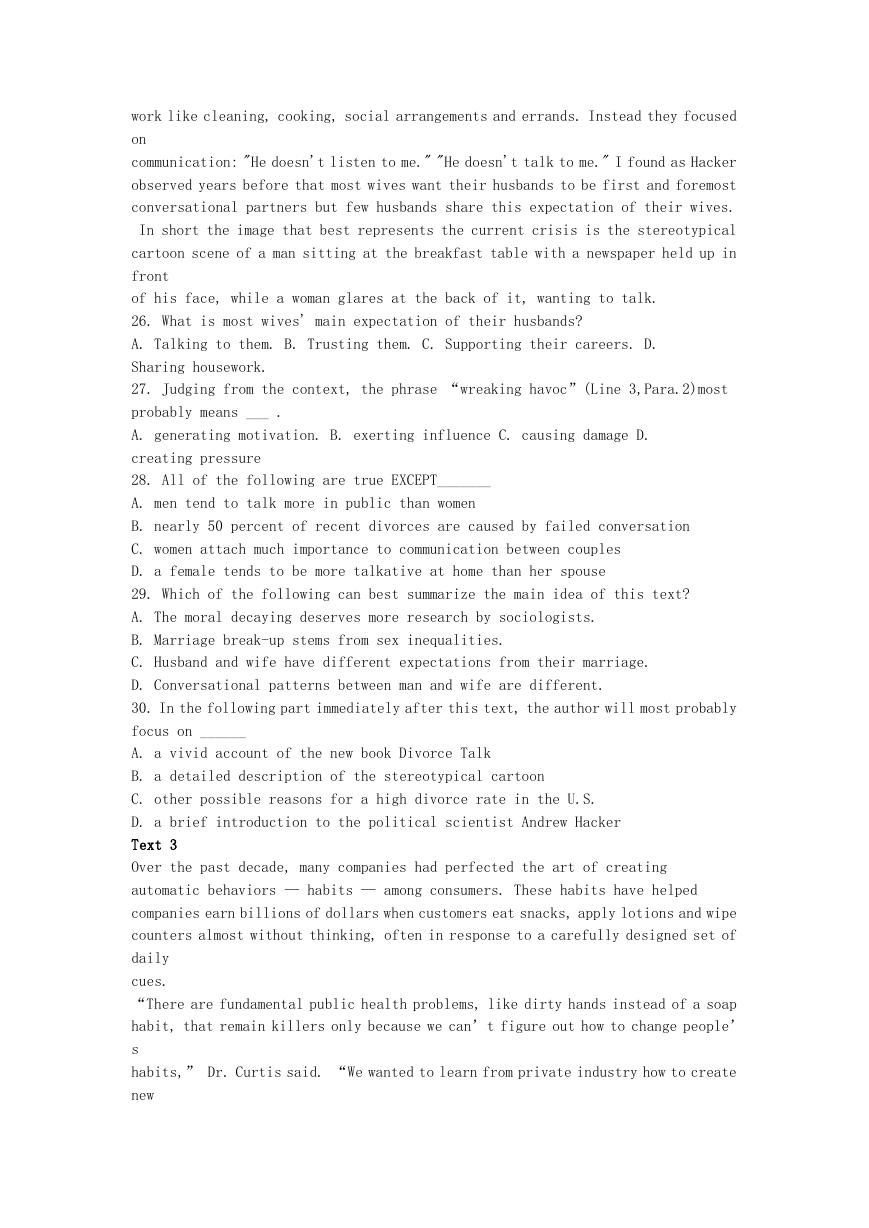
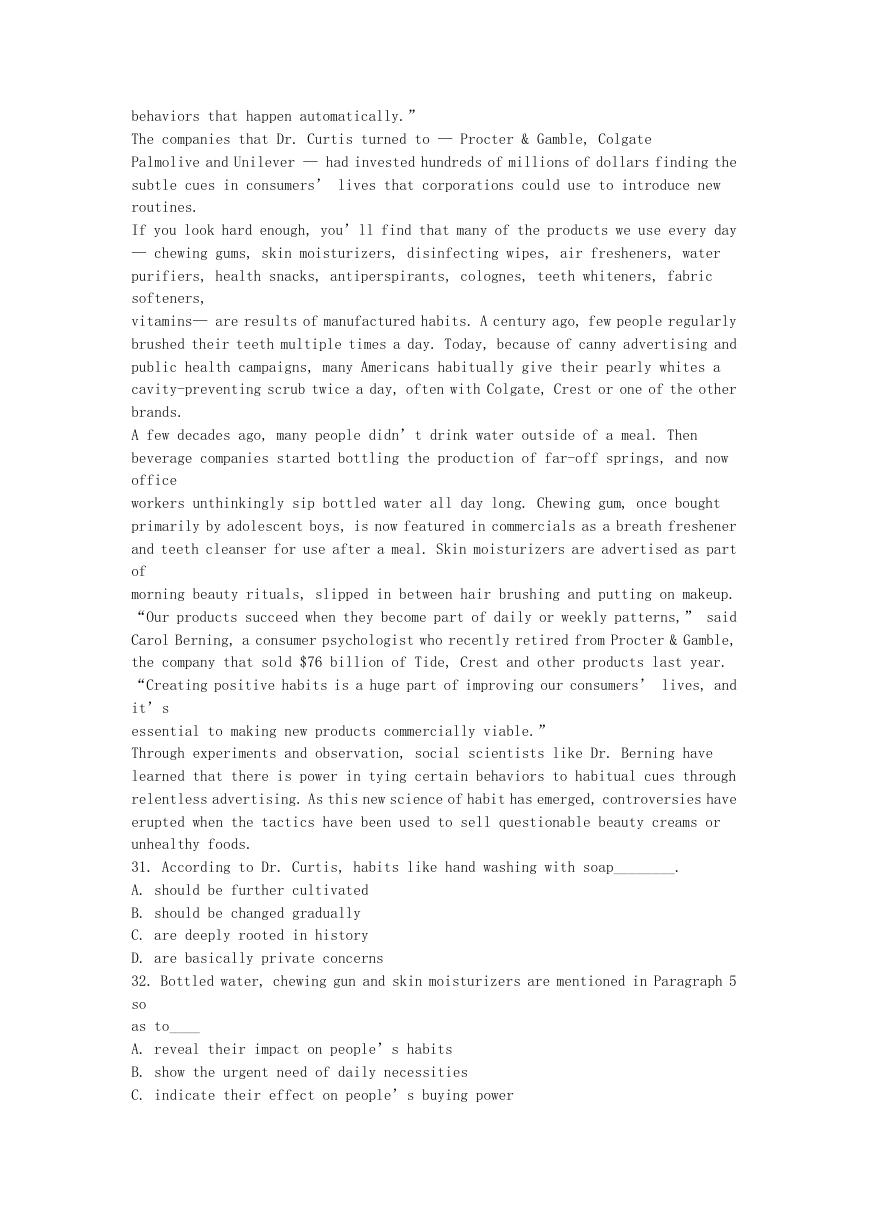
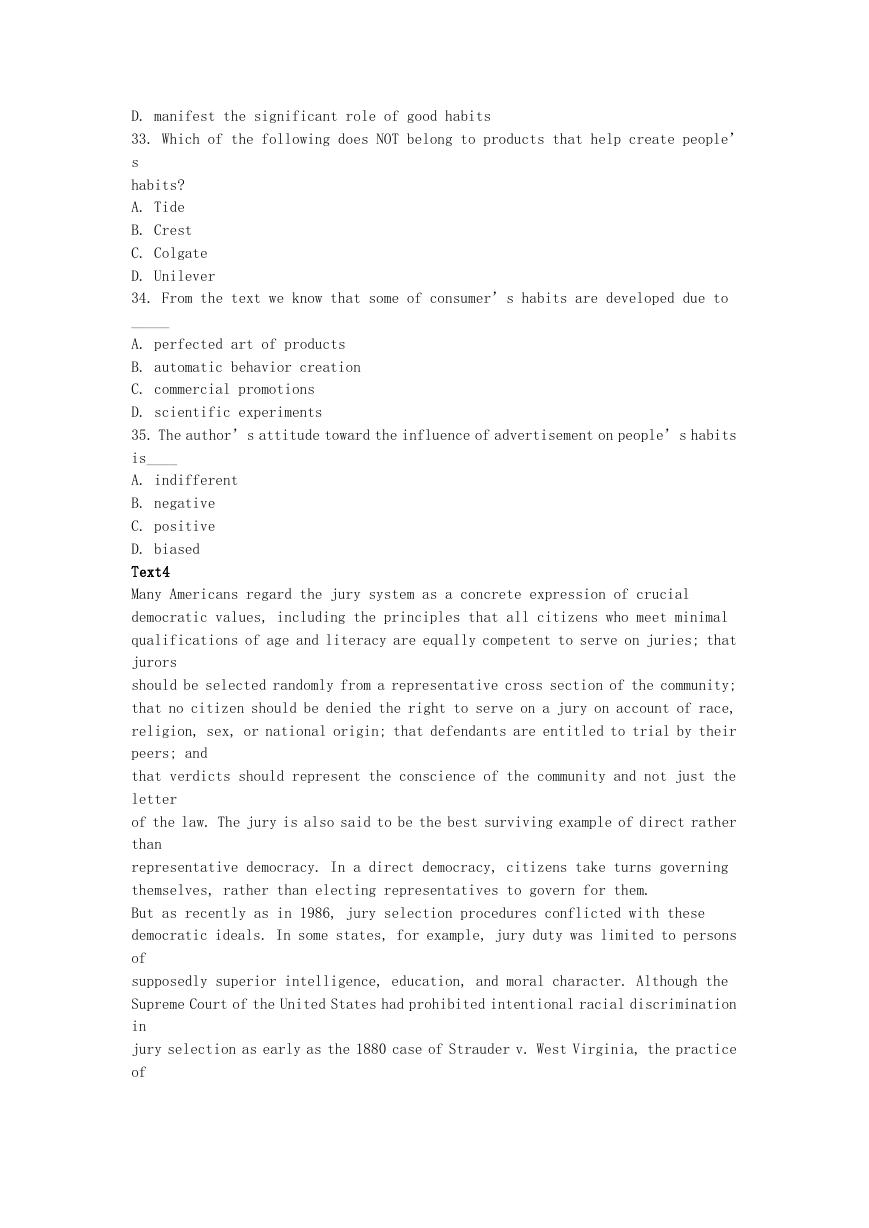








 2023年江西萍乡中考道德与法治真题及答案.doc
2023年江西萍乡中考道德与法治真题及答案.doc 2012年重庆南川中考生物真题及答案.doc
2012年重庆南川中考生物真题及答案.doc 2013年江西师范大学地理学综合及文艺理论基础考研真题.doc
2013年江西师范大学地理学综合及文艺理论基础考研真题.doc 2020年四川甘孜小升初语文真题及答案I卷.doc
2020年四川甘孜小升初语文真题及答案I卷.doc 2020年注册岩土工程师专业基础考试真题及答案.doc
2020年注册岩土工程师专业基础考试真题及答案.doc 2023-2024学年福建省厦门市九年级上学期数学月考试题及答案.doc
2023-2024学年福建省厦门市九年级上学期数学月考试题及答案.doc 2021-2022学年辽宁省沈阳市大东区九年级上学期语文期末试题及答案.doc
2021-2022学年辽宁省沈阳市大东区九年级上学期语文期末试题及答案.doc 2022-2023学年北京东城区初三第一学期物理期末试卷及答案.doc
2022-2023学年北京东城区初三第一学期物理期末试卷及答案.doc 2018上半年江西教师资格初中地理学科知识与教学能力真题及答案.doc
2018上半年江西教师资格初中地理学科知识与教学能力真题及答案.doc 2012年河北国家公务员申论考试真题及答案-省级.doc
2012年河北国家公务员申论考试真题及答案-省级.doc 2020-2021学年江苏省扬州市江都区邵樊片九年级上学期数学第一次质量检测试题及答案.doc
2020-2021学年江苏省扬州市江都区邵樊片九年级上学期数学第一次质量检测试题及答案.doc 2022下半年黑龙江教师资格证中学综合素质真题及答案.doc
2022下半年黑龙江教师资格证中学综合素质真题及答案.doc